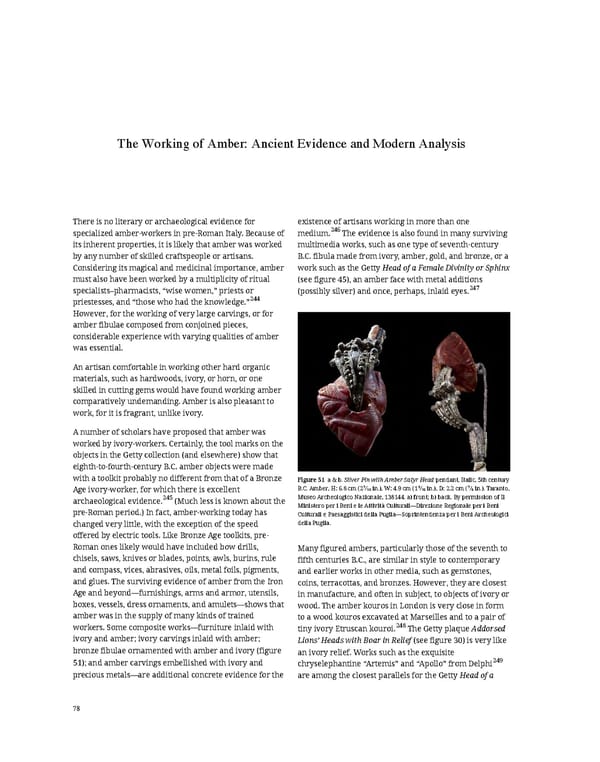The Working of Amber: Ancient Evidence and Modern Analysis There is no literary or archaeological evidence for existence of artisans working in more than one specialized amber-workers in pre-Roman Italy. Because of medium.246The evidence is also found in many surviving its inherent properties, it is likely that amber was worked multimedia works, such as one type of seventh-century by any number of skilled craftspeople or artisans. B.C. fibula made from ivory, amber, gold, and bronze, or a Considering its magical and medicinal importance, amber work such as the Getty Head of a Female Divinity or Sphinx must also have been worked by a multiplicity of ritual (see figure 45), an amber face with metal additions specialists–pharmacists, “wise women,” priests or (possibly silver) and once, perhaps, inlaid eyes.247 priestesses, and “those who had the knowledge.”244 However, for the working of very large carvings, or for amber fibulae composed from conjoined pieces, considerable experience with varying qualities of amber was essential. An artisan comfortable in working other hard organic materials, such as hardwoods, ivory, or horn, or one skilled in cutting gems would have found working amber comparatively undemanding. Amber is also pleasant to work, for it is fragrant, unlike ivory. A number of scholars have proposed that amber was worked by ivory-workers. Certainly, the tool marks on the objects in the Getty collection (and elsewhere) show that eighth-to-fourth-century B.C. amber objects were made with a toolkit probably no different from that of a Bronze Figure 51 a & b. Silver Pin with Amber Satyr Head pendant, Italic, 5th century Age ivory-worker, for which there is excellent B.C. Amber, H: 6.8 cm (27⁄10 in.), W: 4.9 cm (19⁄10 in.), D: 2.2 cm (7⁄8 in.). Taranto, archaeological evidence.245 (Much less is known about the Museo Archeologico Nazionale, 138144. a) front; b) back. By permission of Il pre-Roman period.) In fact, amber-working today has Ministero per i Beni e le Attività Culturali—Direzione Regionale per i Beni Culturali e Paesaggistici della Puglia—Soprintendenza per i Beni Archeologici changed very little, with the exception of the speed della Puglia. offered by electric tools. Like Bronze Age toolkits, pre- Roman ones likely would have included bow drills, Many figured ambers, particularly those of the seventh to chisels, saws, knives or blades, points, awls, burins, rule fifth centuries B.C., are similar in style to contemporary and compass, vices, abrasives, oils, metal foils, pigments, and earlier works in other media, such as gemstones, and glues. The surviving evidence of amber from the Iron coins, terracottas, and bronzes. However, they are closest Age and beyond—furnishings, arms and armor, utensils, in manufacture, and often in subject, to objects of ivory or boxes, vessels, dress ornaments, and amulets—shows that wood. The amber kouros in London is very close in form amber was in the supply of many kinds of trained to a wood kouros excavated at Marseilles and to a pair of workers. Some composite works—furniture inlaid with tiny ivory Etruscan kouroi.248 The Getty plaque Addorsed ivory and amber; ivory carvings inlaid with amber; Lions’ Heads with Boar in Relief (see figure 30) is very like bronze fibulae ornamented with amber and ivory (figure an ivory relief. Works such as the exquisite 51); and amber carvings embellished with ivory and chryselephantine “Artemis” and “Apollo” from Delphi249 precious metals—are additional concrete evidence for the are among the closest parallels for the Getty Head of a 78
 Ancient Carved Ambers in the J. Paul Getty Museum Page 87 Page 89
Ancient Carved Ambers in the J. Paul Getty Museum Page 87 Page 89